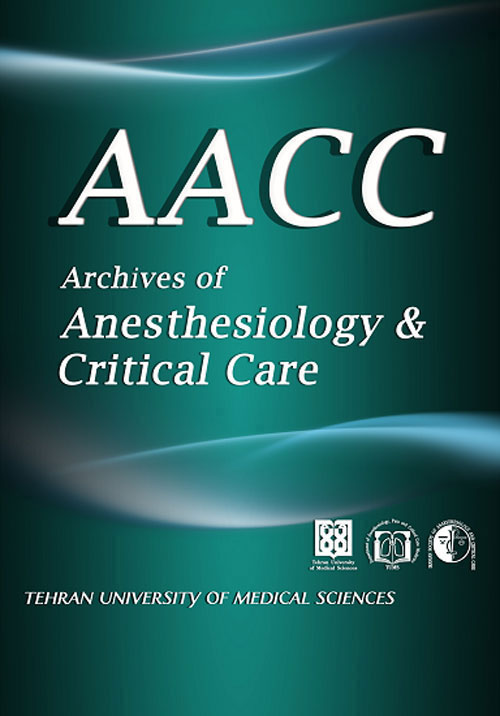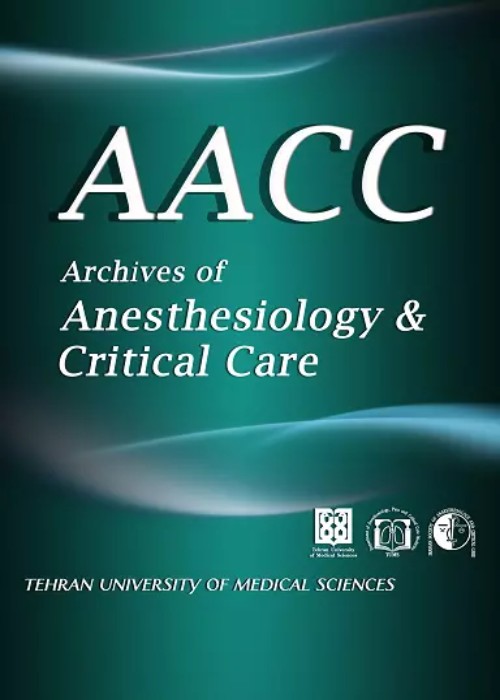فهرست مطالب

Archives of Anesthesiology and Critical Care
Volume:6 Issue: 3, Summer 2020
- تاریخ انتشار: 1399/06/02
- تعداد عناوین: 11
-
-
Pages 109-111Background
One of the most common ailments that plagues patients is Low back pain. Approximately 80% of the population developing some form of back pain in their lifetime. Up regulated sodium channels is the basic cause in the nerve root or dorsal root ganglion for the mechano-sensitization. Functionally both ends of the pseudo unipolar neuron are the same hence injecting the drug in the peripheral end of the nerve will block these sodium channels.
MethodsOpen labelled single group pilot study was conducted on patients reporting at the Pain Clinic of AIIMS, Rishikesh after obtaining consent. In the operation theatre patients received one or two peripheral nerve blocks at a maximum according to their nerve involvement. Outcomes were assessed immediately after injection and at 1st, 2nd, 3rd week after the proposed interventions.
Results30 patients were included in the study. No procedural complications were noted in these 30 patients as the given dose is very less and the site of injection is peripheral. Significant fall in NRS is observed at every visit. Only two patients reported back to pain clinic without pain relief.
ConclusionPeripheral nerve block injection can be used as adjuvant for acute low back ache which is very simple can be administered in an OPD setting without the help of fluoroscopy guidance. Further studies with control group are needed to establish their efficacy.
Keywords: Low back pain, Low dose lignocaine, Peripheral nerve blocks -
Pages 112-117Background
The aim of this study was to assess the quality of the surgical field, amount of blood loss, and duration of surgery following induced hypotension with labetalol, nitroglycerin, and high dose propofol in patients undergoing FESS under general anesthesia.
MethodsOne hundred and eight patients scheduled for FESS under general anesthesia were recruited in this randomized trial and were allocated to one of the three study groups: 1) Nitroglycerine (NTG) group: nitroglycerine with a dose of 2-5 μg/kg/min was administered; 2) Labetalol (LAB) group: an IV bolus dose of labetalol (20 mg) was injected at first and then IV infusion of labetalol at a rate of 1-2 mg/min; 3) High dose propofol plus normal saline (0.5-1 ml/min) group. Hemodynamic variables and the amount of bleeding were recorded intraoperatively and the surgeons' satisfaction was asked following each surgery considering the surgical field quality using a 5-item Likert scale.
ResultsThe average blood loss (ml) in patients in the LAB group was significantly less than patients in NTG and high dose propofol groups (127 ml vs 198 and 145 ml, respectively) (p- value=0.001) and the surgeons expressed greater satisfaction with the surgical field quality in the LAB group (p- value=0.001).
ConclusionLabetalol infusion may be a safe and effective method for induction of controlled hypotension to provide a comparatively bloodless field. High dose propofol may be a second choice if labetalol is not available.
Keywords: Functional endoscopic sinus surgery, Induced hypotension, Labetalol, Nitroglycerine, Propofol -
Pages 118-124Background
Postanesthesia shivering (PAS) is a very common anesthesia-related complication the not only is a discomfortable phenomenon for that patients, but can cause undesirable events and affect the patient’s prognosis negatively. This study compares the high dose ondansetron versus low dose of this agent for PAS control.
MethodsIn this clinical trial 101 patients under general anesthesia for elective surgeries in three groups of premedication with high dose ondansetron (8mg) (n=33), low dose ondansetron (4mg) (n=34) and placebo (normal saline) (n=34) were evaluated. The agents were injected immediately before anesthesia induction, and hemodynamic data, nausea and vomiting incidence and shivering severity were compared.
ResultsMean arterial pressure and pulse rate significantly decreased within the time (P-value<0.05), while oxygen saturation, peripheral and central body temperature did not have statistically significant alterations (P-value>0.05). The duration of recovery room stays and use of meperidine for shivering control were not different in the three groups (P-value>0.05), while incidence of nausea and vomiting and shivering intensity in placebo treated group was worse than ondansetron treated groups regardless of the dose (P-value<0.05). Comparison of two ondansetron treated groups represented insignificant difference considering nausea and vomiting and shivering intensity (P-value>0.05).
ConclusionOndansetron use regardless of the dose was superior to placebo in terms of PAS intensity and nausea and vomiting prevention. Low dose of ondansetron (4mg) was superior to high dose (8 mg) considering the hemodynamic stability, while the two doses were similar in terms of PAS intensity, nausea and vomiting occurrence, duration of recovery room stay and meperidine requirement for shivering control.
Keywords: Ondansetron, Shivering, Postanesthesia shivering, General anesthesia -
Pages 125-132Background
It is widely accepted that increased prevalence of antibiotic resistance of pathogens grown in the respiratory system in intensive care unit (ICU) patients is a very serious problem causing expansion of mortality. The most important strategy to prevent the occurrence and appropriate solution to control the antibiotic resistance is to thoroughly investigate the pattern of resistance in the studied ward. Therefore, the purpose of this study was to determine the antibiotic resistance pattern of organisms isolated from endotracheal tube secretions of patients admitted to ICU of Khatam-Al-Anbia Hospital at Zahedan in Iran.
MethodsIn the present retrospective and descriptive cross-sectional study, the medical records of patients hospitalized during 2013-2018 were included by census method and then selected based on inclusion criteria (n=1387). The required data, including age, gender, type of microorganism isolated from endotracheal tube cultures, antibiotic resistance and sensitivity, duration of intubation and cause of hospitalization, were recorded for each patient. Finally, the data were analyzed by descriptive statistics using SPSS 16 software.
ResultsMean age of patients was 44.66 ± 21.39 years and mean duration of intubation was 17.96 ± 10.99 days. Stroke was the most common cause of hospitalization with a prevalence of 553 patients (49%). The prevalence of positive culture of endotracheal tube secretions was 1128 (81.3%) of which 71.5% were male (n=807) and 28.5% were female (n=321). The cultures of endotracheal tube secretions resulted in 933 (82.7%) gram-negative bacteria, 191 (16.9%) gram-positive bacteria and 4 (0.4%) mixed isolates. The most prevalent gram-negative bacterium was Acinetobacter baumannii (37.2%) with the highest and lowest antibiotic resistance to Meropenem (95.1% resistance) and colistin (99.5% sensitivity), respectively. In addition, the most prevalent gram-positive bacterium was Staphylococcus epidermidis (50.3%) with the highest and lowest antibiotic resistance to Meropenem (85.7% resistance) and Vancomycin (92.2% sensitivity).
ConclusionThe findings of the present study illustrate that there was widespread bacterial resistance to respiratory tract infections in our ICU patients. Due to the high sensitivity of gram-negative bacteria to colistin, the use of antibiotic combination with colistin in the control of pulmonary infections caused by these organisms can be a good choice. In addition, in the case of gram-positive bacteria, the highest sensitivity was to vancomycin; therefore, it can be the selective antibiotic to control infections caused by these bacteria.
Keywords: Endotracheal tube culture, Antibiotic resistance pattern, Antibiotic sensitivity pattern, Intensive care unit, Multi drug resistance -
Pages 133-138Background
Malnutrition is a prevalent complication among critically ill patients. It has very detrimental effects on the patients' clinical course. This study aimed to investigate the impact of nutrition in the intensive care unit (ICU) patients.
MethodsIn this epidemiologic-analytic study conducted in the surgical ICU of Imam Khomeini hospital, Ahvaz, Iran, 34 patients were selected and divided into two groups. The first group of patients received the appropriate nutrition. The second group received an inappropriate diet, and the nutritional risk was evaluated according to the modified- Nutrition Risk in Critically ill (m-NUTRIC) score. The energy was calculated by using 25 Kcal/kg, also the two groups were compared in terms of ICU mortality, ICU stays, Acute Physiologic Assessment and Chronic Health Evaluation (APACHE) II Scoring, and the Sequential Organ Failure Assessment (SOFA) Score.
ResultsBaseline data, such as APACHE II score and mean age, except sex, were not significantly different between the two groups. In this study, results were toward shorter ICU stay, less mortality, and better SOFA score in the group receiving appropriate nutrition compared to the other group. However, due to the low number of patients, no significant differences were observed in the two groups.
ConclusionOur data suggest that nutritional support should be considered as an essential part of the medication during critical illness.
Keywords: Intensive care unit, Malnutrition, Nutritional support, Modified-nutrition risk in critically ill (m-nutric) score -
Pages 139-141
Lumbar epidural analgesia is using widely as an alternative method for anesthesia. Although it has its benefits such as the low risk of complications in contrast with general anesthesia, also it has some adverse effects, for instance: headache, loss of consciousness, pneumocephalus, dizziness, and seizure. Pneumocephalus is a rare complication of lumbar epidural block.In this case of study, a patient represents stenosis in the site of anastomosis of colon and duodenum candidate for a repair surgery with the lumbar epidural block. Epidural catheter insertion was done in the sitting position; local anesthesia was administered at the 4th and 5th lumbar vertebral interspace. A 17-gauge Husted needle was inserted using the loss-of-resistance (LOR) by air technique. Immediately the patient complained of headaches and then deteriorated to a tonic-clonic movement accompanied by post-seizure sleep, which ended up in termination of the procedure. The first-day CT-scan revealed multiple pneumocephalus. Supporting treatment was administered for 10 days; another CT-scan taken from the patient demonstrated improvement and the patient was discharged without any neurological deficit.Regional analgesia should be administered if possible under the superintendence of an expert, however, complications of an epidural catheter, such as accidental dural puncture, can postpone the recovery of the patient.
Keywords: Seizure, Pneumocephalus, Lumbar puncture -
Pages 142-144
Meckel Gruber syndrome (MGS) is one of the rare autosomal recessive inherited disorder affecting several organ systems of the body. It is specifically characterised by occipital encephalocele, bilateral polycystic kidney, post axial polydactyly making the airway management difficult.We would like to share successful management of a case of Meckel Gruber syndrome with giant occipital-cervical encephalocele posted for excision. Difficult airway cart was kept ready prior to intubation. This includes laryngeal mask airway of appropriate size, high frequency jet ventilation, fibre-optic bronchoscope, a cricothyroid cannula and preparations for tracheostomy.Anaesthesia to paediatric age group poses many challenges to anaesthesiologist and that for congenital anomalies add to it. Working knowledge of these kind of syndromes and specific considerations for the same should be kept in mind when assessing a case of occipital encephalocele leading to more effective and appropriate management of cases.
Keywords: Meckel Gruber syndrome, Encephalocele, Airway -
Pages 150-151


